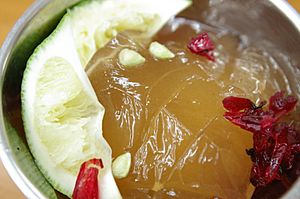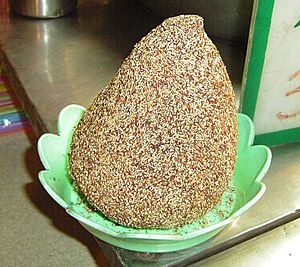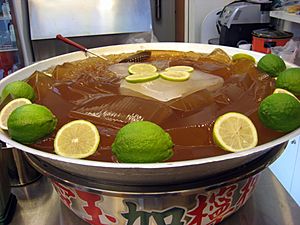Aiyu jelly facts for kids

Aiyu jelly served with a slice of lime and cranberries
|
|
| Alternative names | Ice jelly |
|---|---|
| Place of origin | Taiwan |
| Main ingredients | Fig seed gel |
Aiyu jelly (Chinese: 愛玉冰; pinyin: àiyùbīng; or Chinese: 愛玉凍; pinyin: àiyùdòng; or simply Chinese: 愛玉; pinyin: àiyù), also known as ogio in Amoy Hokkien, is a special jelly from Taiwan. In Singapore, it's called ice jelly. This tasty treat is made from the seeds of a plant called the awkeotsang creeping fig. This plant grows in Taiwan and other parts of East Asia with similar climates.
Aiyu jelly is most common in Taiwan, Malaysia, and Singapore. You might find it in special stores in Japan or in cans in Chinatown areas around the world. It's a popular part of Taiwanese cuisine. In Cantonese, it's sometimes called man tau long. People often enjoy it with a slice of lime.
Contents
Discovering Aiyu Jelly
The story of Aiyu jelly is quite interesting! It's said that a Taiwanese tea businessman discovered it in the 1800s. He was drinking from a creek in Chiayi when he noticed something unusual. There was a clear, yellowish jelly in the water.
He tried the jelly and found it very refreshing. Looking up, he saw fruits hanging from vines above the creek. These fruits had seeds that released a sticky gel when rubbed.
The businessman gathered some of these fruits. At home, he served the jelly with honey and lemon juice or other sweet drinks. Everyone loved how delicious and thirst-quenching it was!
He then asked his 15-year-old daughter, Aiyu, to sell this new snack. It became super popular very quickly. Because of its success, the businessman decided to name the jelly and the plant after his daughter, Aiyu.
How Aiyu Fruit Grows
The fruits of the creeping fig plant look a bit like large figs. They are about the size of small mangos. Tiny insects called Wiebesia pumilae help the flowers grow into fruits.
Farmers usually pick the fruits from September to January. They harvest them just before they turn a dark purple color. After picking, the fruits are cut in half. Then, they are turned inside out and left to dry for several days. You can buy these dried fruits as they are. Or, the dry aiyu seeds (Chinese: 愛玉子; pinyin: aiyu zi) can be taken off the skin and sold separately.
Making Aiyu Jelly at Home
Making aiyu jelly is a fun process! First, you put the aiyu seeds into a cotton cloth bag. Then, you put the bag into cold water. You gently rub and squeeze the bag. As you do this, a slimy, yellowish gel comes out of the seeds. This step is called "washing aiyu" in Chinese.
You keep rubbing and squeezing for a few minutes until no more gel comes out. Then, you throw away the seeds left in the bag. The gel you've collected needs to sit in a cool place or the refrigerator to become a firm jelly.
Here are some important tips for making sure your jelly sets correctly:
- Make sure there is no grease in the container or the water you use.
- Do not add any sugar to the aiyu gel before it sets.
- You must use regular water, not distilled water. The gelling needs minerals found in regular water.
- When washing, don't rub the seeds too hard, or their shells might break.
After the jelly sets, water will slowly start to seep out of it. If you leave it for several days, it will eventually turn back into a liquid.
Aiyu jelly is usually served with honey and lemon juice. It can also be added to other sweet drinks or shaved ice. It's a perfect cool treat, especially during hot summer days!
The Science Behind the Jelly
The special ingredient that makes aiyu seeds turn into jelly is called pectin. This pectin is found in a clear layer on the outside of the seeds. That's why you rub and wash the seeds to get the gel out, instead of grinding them into a powder.
The main type of pectin in aiyu seeds is called LMP (low methoxy pectin). This type of pectin forms a jelly when it mixes with certain minerals in water. These minerals are called "divalent cations" and are naturally present in regular water. This is why using regular water is important for the jelly to form properly.
ja:アイギョクシ zh:愛玉子
See also
 In Spanish: Gelatina de aiyu para niños
In Spanish: Gelatina de aiyu para niños



